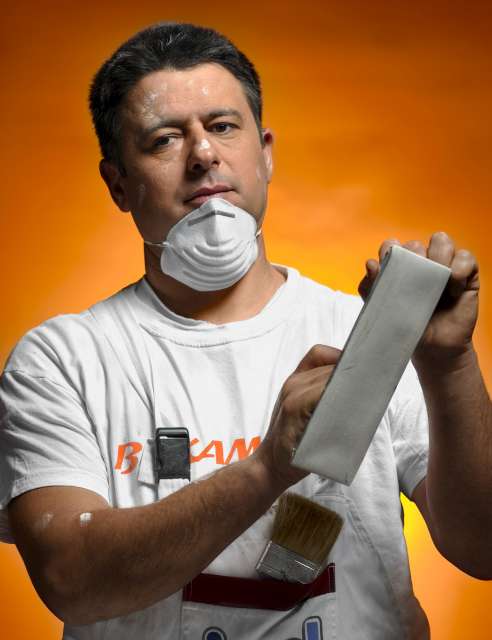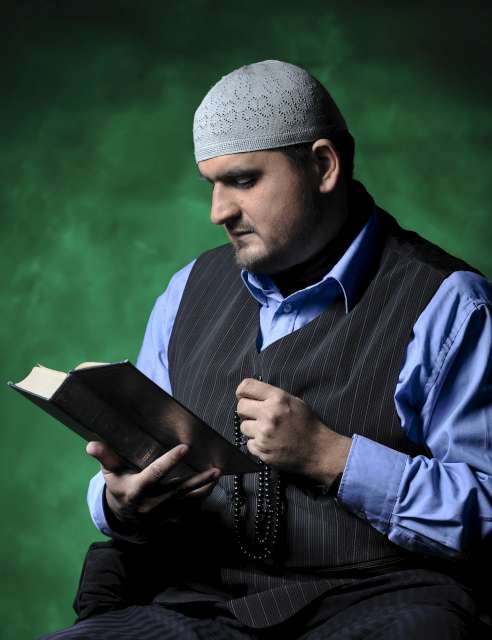- Text size
 |
|  |
|  |
| 
- Français
Q&A: A positive photographic portrayal of Montenegro's Roma community
News Stories, 28 April 2010
PODGORICA, Montenegro, April 28 (UNHCR) – In the past two decades, Montenegrin photographer Dusko Miljanic has exhibited his work in his own country and around the world. The 35-year-old specializes in documentary photography and his images have won awards at home and abroad. Earlier this month, his latest exhibition opened in Podgorica with the backing of the government and United Nations organizations with a presence in Montenegro, including the UN refugee agency. "Barvale" comprises 32 colour portraits of Roma, including two children, who have been successful in their lives, including musicians, chefs, sports stars, politicians, actors, businesspeople and the like. Miljanic talked to UNHCR Associate Programme Officer Gordana Popovic about the exhibition. Excerpts from the interview:
Tell us about the exhibition
I've been working on the project since 2008 and my aim was to show the Roma, Ashkalia and Egyptian people in a different way. "Barvale" means successful in the Roma language and I've rejected the stereotypical images of a people living on the fringes of society and in poverty. I took studio portraits that depicted my Roma subjects as pop icons, movie stars and the like. It's putting them on the same level as the rest of contemporary Montenegrin society. My subjects included Roma refugees in Montenegro as well as members of long-established Roma communities in the country. The exhibition also includes information about their professional and personal successes, which counter stereotypes, reject widespread prejudices and try to alter perceptions that are based on ignorance. Each of my subjects has a message for the audience; most of them stressed the importance of education in helping them to break the cycle of poverty.
Some of the subjects are refugees. Can you tell us a bit more?
Yes, nine of them are refugees from Kosovo. I am fascinated with their determination and success in starting up life in a new country despite all the challenges and obstacles.
Have you ever visited camps for Roma refugees?
I have visited several camps housing Roma refugees in the Balkans, in Montenegro, Serbia and Romania. Experiences are different, as well as feelings, from admiration for the picturesque situation I found myself in, to deep sadness for people living in such an extreme hardship. [UNHCR also has a programme to assist stateless Roma in Montenegro and other countries in the region.]
When did you become interested in the Roma?
As a child I knew several Roma families and some of my classmates at primary school were Roma. This was at a time when Montenegro was part of the Socialist Federal Republic of Yugoslavia. Later, as a photographer-artist, I often visited the Roma refugee settlement in Podgorica's Konik suburb and shot black-and-white documentary images of the community. But I always wanted to do something different and I have achieved that with the Barvale exhibition.
Do you think that art can help marginalized groups?
Simple photographs that carry a message are an excellent means of engaged art, which leaves nobody indifferent. I have witnessed through this project how perceptions and awareness can change in a very short time. Many people, including friends and those helping with the exhibition, asked why I bothered to photograph Roma subjects. And the Roma themselves were surprised as they were so used to the stereotyped documentary-style portrayal of their situation in black-and-white.
What do you hope the exhibition will achieve?
I hope that this exhibition changes at least a percentage of the embedded [negative] perceptions towards the Roma population, which are based on ignorance. I also want to show that we can see, judge, think and interact differently. I'm hopeful that Barvale will be shown in many communities in Montenegro and also in other countries in the region.
The project has already helped one vulnerable family by connecting it with an aid agency that could help. I was visiting my subjects to tell them about the project and to take black-and-white photos of their everyday lives to complement the colour studio portraits. During one of these trips I visited the home of Kameri Keca, who headed a family of nine refugees from Kosovo. I looked around the room to choose the best angle for the photo when I noticed that water was running down the walls. I was shocked and told UNHCR staff about this. They immediately visited the family and arranged for an implementing partner, the [German] non-governmental organization HELP, to supply them with construction materials to fix the problem. So, I'm happy that this exhibition is not only helping to change attitudes, but also to improve somebody's life.
Tell us about your relationship with UNHCR
I was hired by the UNHCR office here three years ago to teach their staff how to take good photographs for use in publicity and media reports. During this time, I shared with them the idea that eventually became Barvale and which UNHCR and the other UN organizations present in Montenegro helped me to implement.

























